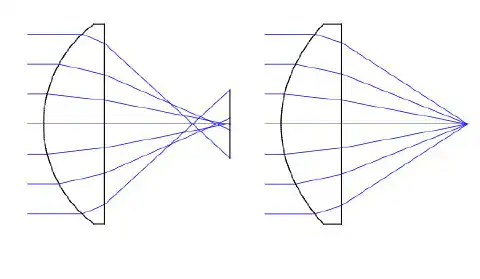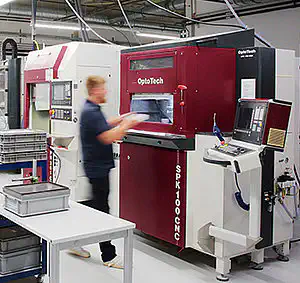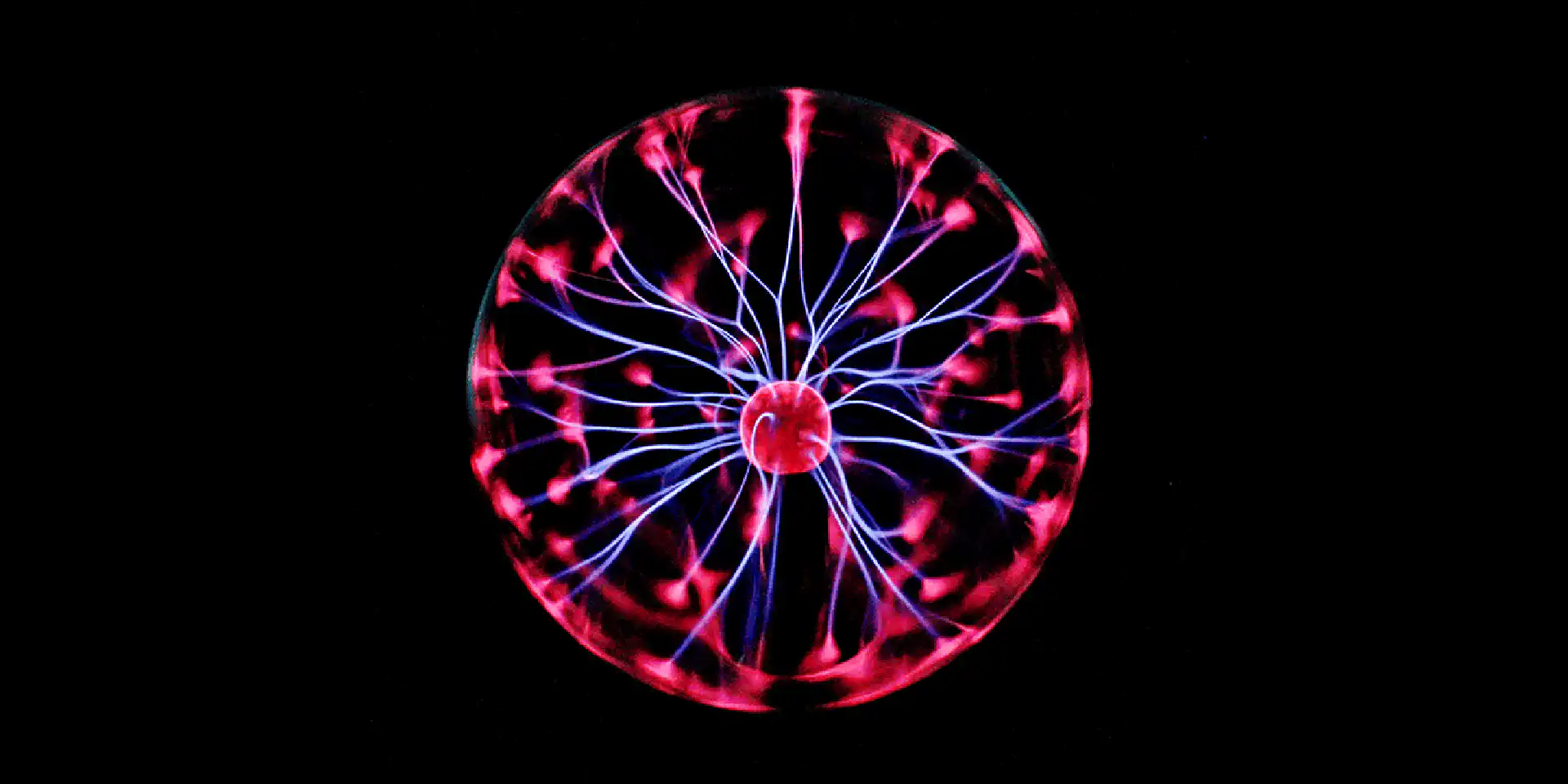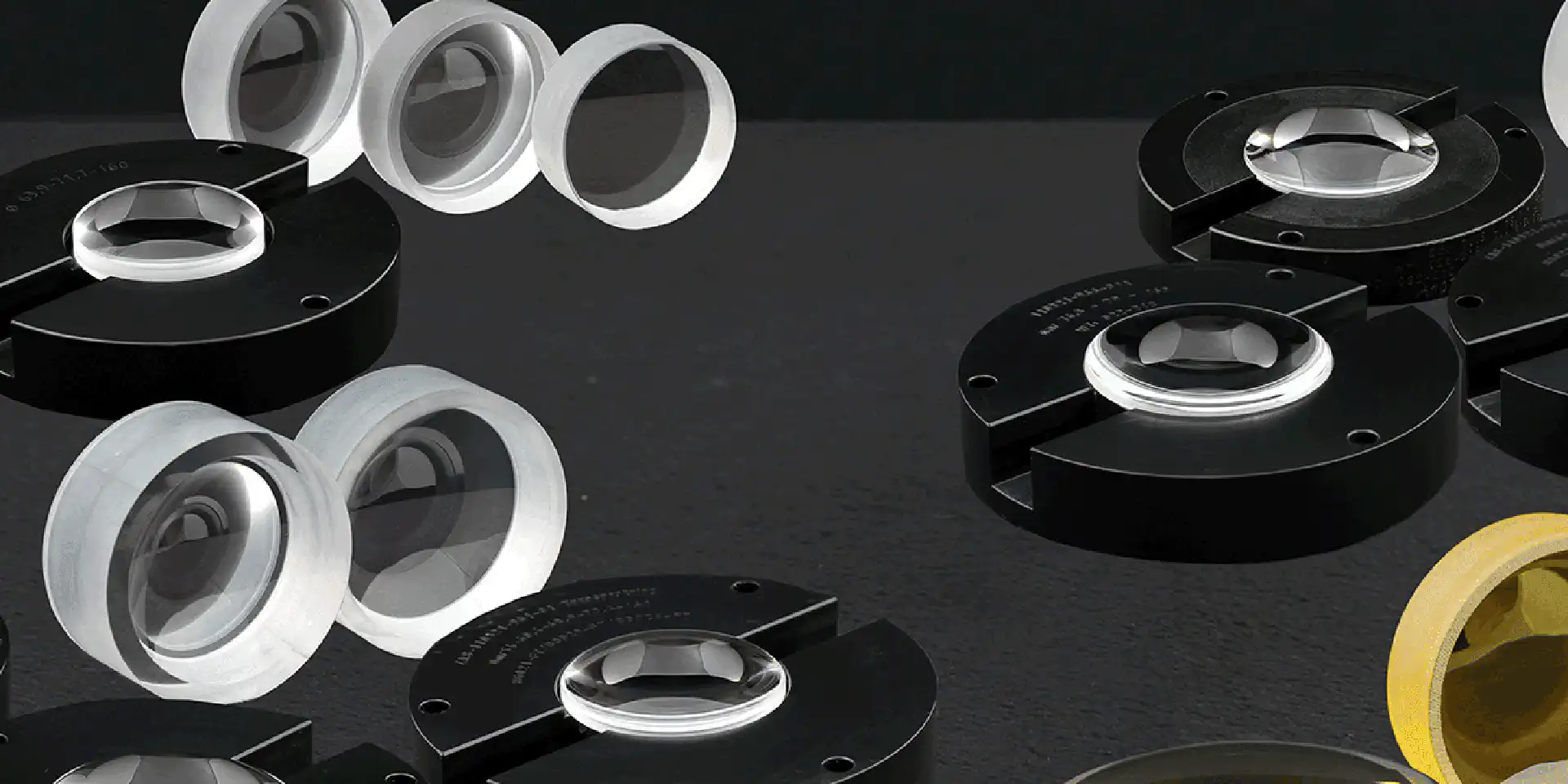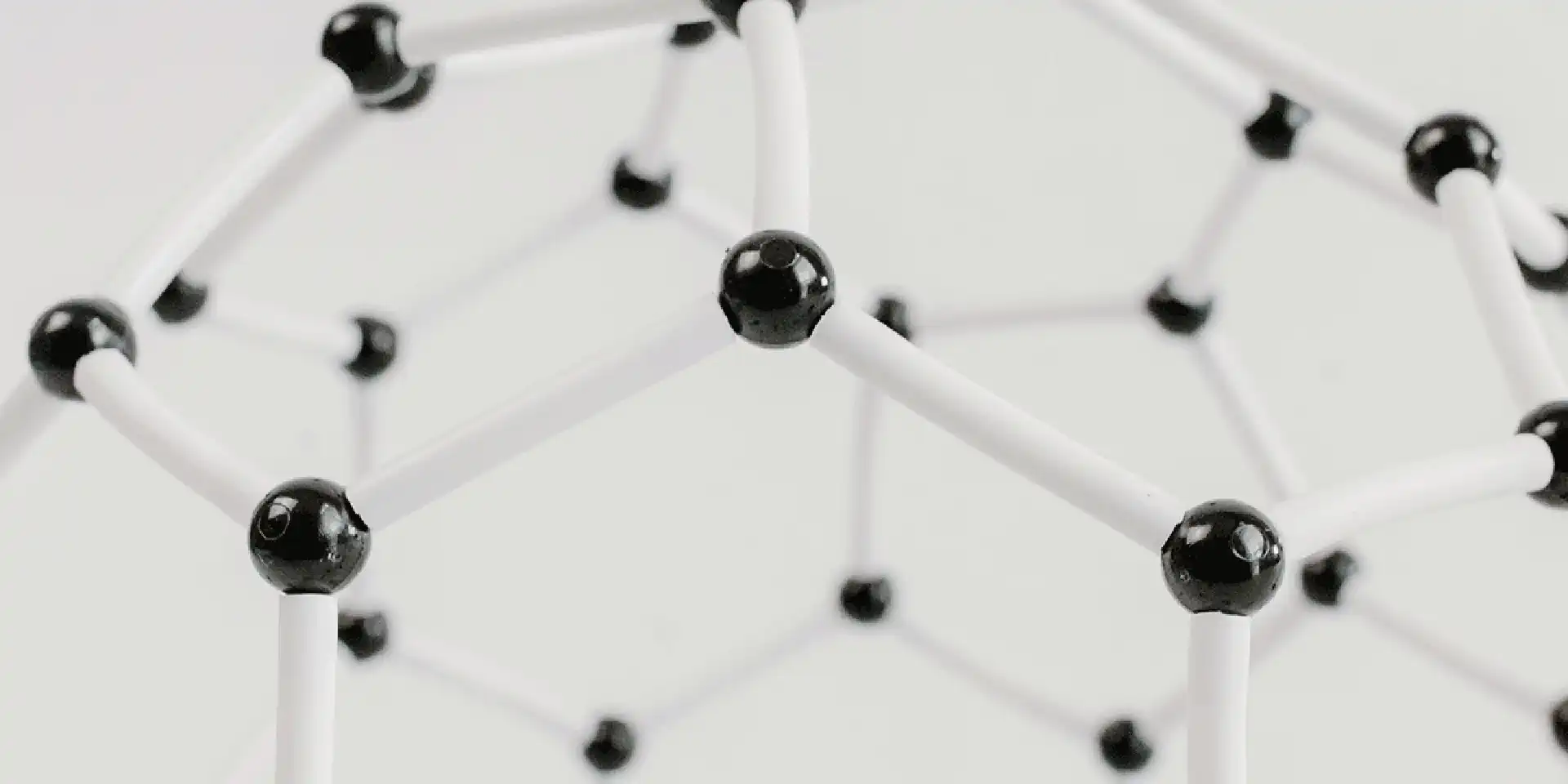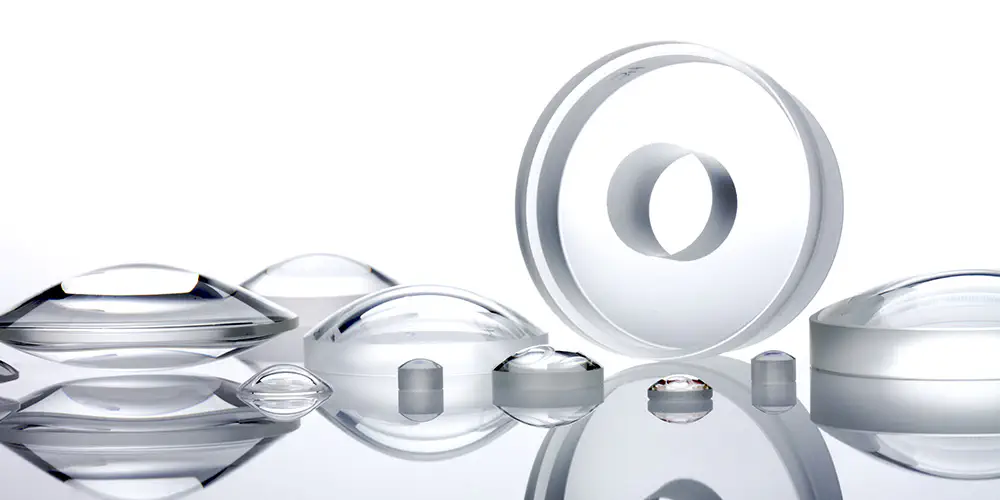
Aspheric lenses
Precision-polished aspheres with best imaging properties - customized & off-the-shelf.
Aspheric optics from asphericon
Aspheres have much better imaging properties than spherical lenses thanks to the surface geometry that deviates from a sphere. The main benefit is the ability to correct spherical aberrations. The total number of optical elements in an optical system can be reduced by using an aspheric lens. This enables a significantly more compact and efficient setup than is the case for a comparable system with spherical lenses.
Correction of aberrations
Based on an unique technology, asphericon is able to produce aspherical optics with a surface form deviation (RMSi) from up to 0,01 µm. In cooperation with our customers we are developing and producing suitable solutions for a big variety of optical lenses – from the prototype to series. Choose an individual Custom solution or use the innovative diversity of our stocked aspheric lens from the StockOptics product line. a|Aspheres are available in our web shop with surface form deviations of RMSi ≤ 0.5 μm and RMSi <0.3 μm. Due to precise focusing properties, all optics and components from asphericon are suitable for a wide variety of applications.
Discover our extensive range of individual and stocked aspherical optics, assemblies and optical systems - discover the possibilities we offer in-house for your aspheric lenses:
- Customer-specific optical designs,
- High-quality optical coatings for the spectra UV, VIS and IR,
- Implementation of mounted optical elements,
- Tactile and interferometric measuring/en/solutions/services/metrology/,
- Optical characterization as well as
- Refinement, like edge varnishing and laser marking
RoHS & REACH conformity
asphericon manufactures according to RoHS and REACH regulations which is guaranteed by appropriate certificates.
Discover different materials and diamters for every wavelength and focal length
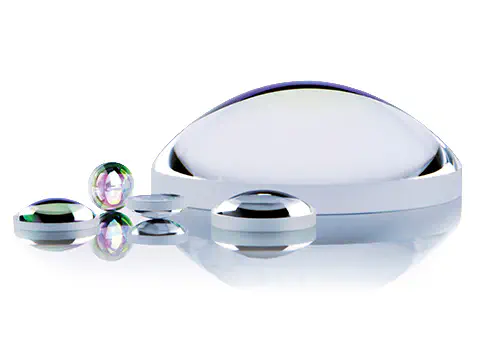 High-NA
High-NA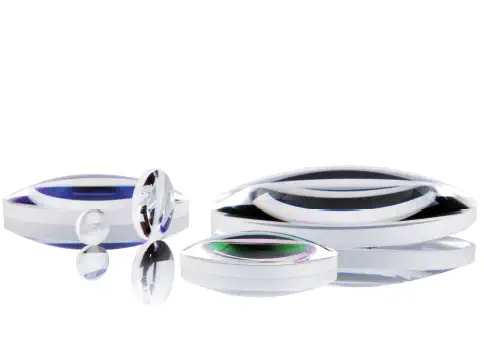 Low-NA
Low-NA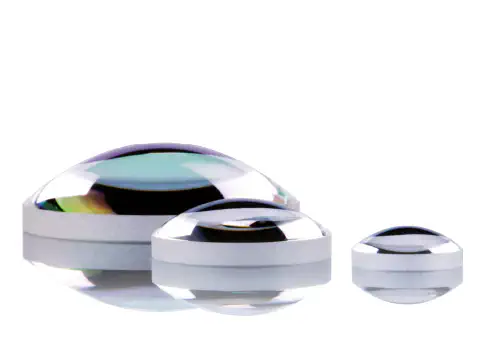 Fused silica
Fused silicaAdditional information
Correction of aberrations
Mathematical description of an aspheric lens
z = Sag of surface
h = Distance perpendicular to the optical axis (height of incidence)
R = Radius
k = Conic constant
A2i = Aspheric coefficients of the correction polynomial
If the respective aspheric coefficient of a rotationally symmetric asphere is zero, the resulting surface profile is considered conical. Depending on the conic constant k, one of the following conic sections serves as a surface shape description:
k = 0 - Sphere
k > -1 - Ellipsoid
k = -1 - Parabola
k < -1 - Hyperbola
With ISO 10110, which was renewed in 2015, there is an alternative to the traditional description of aspheric surfaces. Based on orthonormal polynomials, it can be used to model the real difference in deflection to the best-fitted spherical shape of the aspherical lens. The new formula also includes the surface quotient Qm and reads:
The revised formula offers far-reaching advantages that simplify the surface description. One major advantage is that fewer significant digits are required to describe the surface profile. A further advantage is the maximum sag departure deflection deviation. This can be estimated by multiplying the largest coefficient Am by the maximum amplitude for the order of this coefficient.
Aspheric surface profile
Figure: Comparison of the three most frequent surface form imperfections (form error, waviness, and surface roughness) according to shape and type of deviation
The three most reported surface shape imperfections are:
• Surface form error,
• Waviness and
• Surface roughness.
They represent deviations of the real surface from the ideal surface, as for the aspheric lens. The parameters used to describe the surface profile allow a prediction of the quality of a manufactured lens profile after processing. A high surface quality can among other things be achieved by a high process stability.
Surface form error
The form error describes the difference between the lowest and highest point of the test surface. Metaphorically speaking, it refers from mountain to valley, therefore the form error is given by the PV value, peak-to-valley. The PV value is one of the most important surface specifications for inspecting the surface of an aspheric lens. It is evaluated in waves or in fringes. It is also possible to specify it as an RMS or micrometer deviation. The RMS value (Root Mean Square) describes the mean square difference between the ACTUAL and the TARGET surface, taking into account the area of the defect.
Waviness
Waviness errors on an aspheric lens can be caused, for example, by polishing tools during the machining process. This surface deviation is therefore application specific. The waviness has a longer wavelength than the roughness, which is why the short wavelengths are filtered out for their examination. Only low frequencies may pass. It is often also referred to as the inclination error, which is examined over a defined length. A specification of waviness tolerances is only necessary if the waviness has an effect on the optical task of the aspheric lens.
Surface roughness
Surface roughness describes smallest irregularities on the optical surface. Therefore, only the short wavelengths are examined for analysis and low frequencies are filtered out. Surface roughness is a dimension for the quality of polishing processes. The effect on optical applications of the aspheric lens can often be decisive. For example, a high degree of roughness can lead to a faster wear of the aspherical lens as soon as high powers, such as those of a laser, act on it. In addition, scattering reduces the quality of the measurement results, which is why low surface roughness is considered a high-quality feature. In industries such as metrology or aerospace this is of importance. The determination of surface roughness is part of the manufacturing process, especially for high-quality aspheric lenses.
asphericons standards in the production of high-precision optics
asphericon has specialized in the production of aspheric lenses by grinding, polishing, diamond turning and high-end finishing. In this process a blank is subjected to various work steps:
• Grinding or diamond turning for shaping,
• Polishing the ground aspheric lens,
• Measurement for form and surface inspection,
• Measurement and processing by means of high-end finishing.
Grinding and polishing
Blanks are already shaped lenses and the starting material for the further process to produce an aspheric lens. In the first work step, the blank is ground to give it its desired shape. Various grinding tools and technologies are used for this complex process. The ability to simulate the individual process steps using asphericon’s unique CNC control software allows for an unprecedented realization, for high flexibility and reliability during the entire process. In the following, the polishing process is an important part in the production of an aspheric lens. Step by step, the surface is reworked to achieve the desired requirements (e.g. the surface shape deviation). Polishing can be done by machining with geometrically undefined, very fine grain, but also by chemical removal. A finished polished lens has a bright surface without pores and depth cracks as well as the desired shape accuracy and surface quality.
Diamond Turning
The diamond turning process is an alternative machining method for shaping an aspheric lens. A monocrystalline diamond is used to machine the lens surface. In contrast to grinding tools, this is much smaller and more filigree. Due to its high hardness, ultra-precise machining of the lens is possible, resulting in an improved surface quality. By means of diamond turning, non-ferrous metals, nickel-phosphorus layers, crystals, and IR-glasses can be machined, in addition to an aspheric lens made of plastic.
Measurement of the aspheric lens
• Tactile measuring methods up to diameters of 260 mm
• Full-surface, non-contact measurement up to 420 mm
• Non-contact center thickness measurement
• Roughness measurement Ra < 0.5 nm RMS, measuring field up to 1x1 mm
• Measurement of freeforms, shape and positional tolerances, roughness
• Measurement/positional check of mounts, mounted aspheric lenses and complete systems
• Confocal 3D defect characterization
Tactile measurement
With tactile measuring methods, the surface of an optical component is scanned with a probe. Differences in height between the scanned surface section and the nominal surface of the measured object are determined. The determined data of the height differences are then analysed and evaluated by a software. A rigid touch probe system and a contact pressure of the probe ball that is as constant as possible are required for the exact determination of the surface contour. Among more complex tactile measuring devices are the 3D coordinate measuring system and the form tester Mahr MFU, both used at asphericon.
Interferometric measurement
Much more common are interferometric measuring methods for testing an aspheric surface. Interferometers are based on the principle of interference, i.e. the superposition of two coherent light waves (the test beam and the reference beam). A characteristic interference fringe pattern is produced which is used to evaluate the optical surface. The interference fringes are differences in intensity caused by a phase shift of the test wave to the reference wave. This means that surface deviations of the aspheric lens from the ideal shape become visible. To measure an aspheric lens, a computer-generated hologram (CGH) is sometimes additionally required to generate the aspheric reference wavefront. Such a measurement is repeated in phase-shifting measurement methods with several shifts of the reference surface, resulting in a full-surface error map of the aspheric lens to be measured. The MarOpto TWI 60 measuring system, which has been used by asphericon since 2017, is considered a pioneer in optical metrology and measures without CGHs. The modern interferometer measures using differently tilted wave fronts and thus inspects aspheric lenses and freeforms in seconds.
Application examples of the aspheric lens
Telescopes today, for example, are almost always aspherical, especially those with larger diameters. Aspheric elements are also used in zoom lenses. Not only the system size is reduced but also the imaging quality is increased compared to applications with spherical lenses.
For star observation, but also in the aerospace industry, aspheric lenses can be used. The Sentinel-4 satellite, for example, contains aspheric optics from asphericon in its spectrometers. For use in space, the optics do not only need excellent optical properties, but also have to withstand extreme environmental conditions. Here you can learn more about Sentinel-4.
Another field of application is laser beam shaping, such as the generation of Top-Hat beam profiles. In a beam shaping system with two aspheric lenses for Top-Hat light distribution the first lens is used to redistribute the incoming laser beams (Gaussian distribution) in such a way that a homogeneous intensity distribution is achieved at a certain distance. The second lens collimates the beam and as a result, the characteristic Top-Hat distribution is created. These aspheric applications are of interest in material processing (e.g. cutting of metal) and also in medical applications (e.g. ophthalmology). A detailed description of laser beam shaping with aspheric lenses and other application examples can be found in our blog.
Imaging ophthalmological-instrumental procedures also work with aspheric lenses. Installed in special instruments, they support preventive and postoperative examinations, treatments, and diagnoses of the eye, such as ocular fundus examinations using a slit lamp or fundus camera. In addition to high-resolution imaging, aspheric lenses guarantee a more compact design of ophthalmological observation systems as well as very good imaging qualities.
In industrial areas such as manufacturing, quality control or robotics, high-quality camera systems are required. These are equipped with lenses, which can be based on aspheric lenses. Even under the most difficult conditions, such as high temperatures under constant use, the lenses must withstand. Their task is to focus the light scattered by the object onto a light-sensitive sensor. By passing through several different process steps, important data is transported to its destination.
A relatively new application for aspheric lenses on the market is the field of metrology. Their use can significantly reduce the total number of lenses used in a Fizeau transmission sphere and increases the measuring range. Another advantage: the transmission sphere is also significantly lighter thanks to the use of fewer lenses. For information on the use of aspheric lenses in transmission spheres, please refer to the reference for our aspheric Fizeau lens.
Custom Aspheres
Looking for a custom solution? Discover our customized aspheres with unsurpassed surface quality and following specifications::
- Aspheric optics for UV/VIS/IR range
- Individual optical designs for for all types of applications
- Diffraction-limited quality with a Strehl ratio up to 0.99
- Outstanding surface quality with roughness values as low as 5 Å
- High-end optical coatings
Technical data customized aspheres*
| Standard-Quality | Precision-Quality | High-End-Finishing | Diamond-Turning | |
|---|---|---|---|---|
| Diameter | 8-300 mm | 4-250 mm | 6-300 mm | 1-420 mm |
| Center thickness | 2-60 mm | 2-60 mm | < 60 | ab 0,5 mm |
| RMSi Irregularity | 0,75-0,3 µm | 0,09 µm | < 0,015 µm | 20 nm |
| Surface roughness | 3 nm | 1,5 nm | 0,5 nm | 1 nm |
| Surface Imperfections (Scratch/Dig) | 60 - 40 | 40 - 20 | 10 - 5 for Ø <2"; 20 - 10 for Ø >2" | |
| Full-surface interferometric measurement | optional | optional | guaranteed | guaranteed |
| Coating | customer-specific | |||
| Materials | customer-specific** | |||
| Mounting | customer-specific | |||
| RoHS & REACH Conformity | certified |
📎 Download data sheet production capabilities
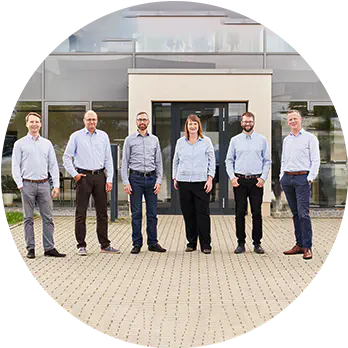

StockOptics Aspheres
Choose between asphericon a|High-NA, a|Low-NA and a|UV-grade fused silica as well as up to three different quality levels (Precision, Ultra and BeamTuning). Thanks to CNC polishing and grinding this aspheric lens meets the highest demands on production quality and tolerance:
- Precision polished Aspheres (a|High-NA made of S-LAH64, a|Low-NA made of N-BK7 and a|FusedSilica made of fused silica)
- Quality levels: Precision (RMSi < 0.5 µm, wavefront RMS up to < 235), Ultra (RMSi up to < 0.1 µm; wavefront RMS up to < 51) and BeamTuning (RMSi < 0.02 µm; wavefront RMS < 10)
- CNC grinding & polishing for superior surface roughness
- Materials: S-LAH64, N-BK7, FusedSilica
- Diameter: 10 mm to 100 mm
- Available with high-quality AR- and V-coatings
- Off-the-shelf delivery for short lead times
- Files for optical design and drawings available (Zemax, CodeV, OSLO, VirtuelLabTM, Step)
Aspheric lenses: Our product selection
Unmounted aspheric lenses
| Product Code | RMSi [nm] | Wavefront RMS [nm] | Diameter [mm] | EFL [mm] | NA | f/d | WD [mm] | λDesign [nm] | Material | Scratch-Dig | Coating | Price uncoated | Price coated | |
|---|---|---|---|---|---|---|---|---|---|---|---|---|---|---|
| AHL10-08-P-U | 500 | 390 | 10 | 8 | 0.55 | 0.80 | 6.0 | 780 | S-LAH64 | 60-40 | A / B / C | 166.00 | 195.00 | Quote |
| AHL12-10-P-U | 500 | 390 | 12.5 | 10 | 0.55 | 0.80 | 7.6 | 780 | S-LAH64 | 60-40 | A / B / C | 194.00 | 222.00 | Quote |
| AHL15-12-P-U | 500 | 390 | 15 | 12 | 0.55 | 0.80 | 9.0 | 780 | S-LAH64 | 60-40 | A / B / C | 207.00 | 236.00 | Quote |
| AHL18-15-P-U | 500 | 390 | 18 | 15 | 0.53 | 0.83 | 11.5 | 780 | S-LAH64 | 60-40 | A / B / C | 222.00 | 261.00 | Quote |
| AHL20-18-P-U | 500 | 390 | 20 | 18 | 0.49 | 0.90 | 14.0 | 780 | S-LAH64 | 60-40 | A / B / C | 236.00 | 272.00 | Quote |
| AHL25-20-P-U | 500 | 390 | 25 | 20 | 0.54 | 0.80 | 15.7 | 780 | S-LAH64 | 60-40 | A / B / C | 249.00 | 286.00 | Quote |
| AHL30-26-P-U | 500 | 390 | 30 | 26 | 0.52 | 0.87 | 20.6 | 780 | S-LAH64 | 60-40 | A / B / C | 319.00 | 366.00 | Quote |
| AHL45-32-P-U | 500 | 390 | 45 | 32 | 0.61 | 0.71 | 24.2 | 780 | S-LAH64 | 60-40 | A / B / C | 417.00 | 520.00 | Quote |
| AHL50-40-P-U | 500 | 390 | 50 | 40 | 0.55 | 0.80 | 31.3 | 780 | S-LAH64 | 60-40 | A / B / C | 445.00 | 569.00 | Quote |
| AHL10-08-U-U | 100 | 78 | 10 | 8 | 0.55 | 0.80 | 6.0 | 780 | S-LAH64 | 60-40 | A / B / C | 333.00 | 386.00 | Quote |
| AHL12-10-U-U | 100 | 78 | 12.5 | 10 | 0.55 | 0.80 | 7.6 | 780 | S-LAH64 | 60-40 | A / B / C | 388.00 | 442.00 | Quote |
| AHL15-12-U-U | 100 | 78 | 15 | 12 | 0.55 | 0.80 | 9.0 | 780 | S-LAH64 | 60-40 | A / B / C | 416.00 | 473.00 | Quote |
| AHL18-15-U-U | 100 | 78 | 18 | 15 | 0.53 | 0.83 | 11.5 | 780 | S-LAH64 | 60-40 | A / B / C | 444.00 | 522.00 | Quote |
| AHL20-18-U-U | 100 | 78 | 20 | 18 | 0.49 | 0.90 | 14.0 | 780 | S-LAH64 | 60-40 | A / B / C | 470.00 | 543.00 | Quote |
| AHL25-20-U-U | 100 | 78 | 25 | 20 | 0.54 | 0.80 | 15.7 | 780 | S-LAH64 | 60-40 | A / B / C | 500.00 | 572.00 | Quote |
| AHL30-26-U-U | 100 | 78 | 30 | 26 | 0.52 | 0.87 | 20.6 | 780 | S-LAH64 | 60-40 | A / B / C | 638.00 | 735.00 | Quote |
| AHL45-32-U-U | 100 | 78 | 45 | 32 | 0.61 | 0.71 | 24.2 | 780 | S-LAH64 | 60-40 | A / B / C | 834.00 | 1039.00 | Quote |
| AHL50-40-U-U | 100 | 78 | 50 | 40 | 0.55 | 0.80 | 31.3 | 780 | S-LAH64 | 60-40 | A / B / C | 890.00 | 1141.00 | Quote |
| ALL12-25-P-U | 500 | 255 | 12.5 | 25 | 0.25 | 2.0 | 22.4 | 780 | N-BK7 | 60-40 | A / B / C | 194.00 | 222.00 | Quote |
| ALL25-50-P-U | 500 | 255 | 25 | 50 | 0.23 | 2.0 | 46.0 | 780 | N-BK7 | 60-40 | A / B / C | 249.00 | 286.00 | Quote |
| ALL50-100-P-U | 500 | 255 | 50 | 100 | 0.24 | 2.0 | 93.4 | 780 | N-BK7 | 60-40 | A / B / C | 445.00 | 588.00 | Quote |
| ALL75-60-P-U | 500 | 255 | 75 | 60 | 0.62 | 0.8 | 36.5 | 780 | N-BK7 | 60-40 | A / B / C | 759.00 | 980.00 | Quote |
| ALL75-150-P-U | 500 | 255 | 75 | 150 | 0.23 | 2.0 | 140.1 | 780 | N-BK7 | 60-40 | A / B / C | 759.00 | 980.00 | Quote |
| ALL100-100-P-U | 500 | 255 | 100 | 100 | 0.48 | 1.0 | 76.2 | 780 | N-BK7 | 60-40 | A / B / C | 1056.00 | 1443.00 | Quote |
| ALL100-200-P-U | 500 | 255 | 100 | 200 | 0.23 | 2.0 | 187.4 | 780 | N-BK7 | 60-40 | A / B / C | 1056.00 | 1443.00 | Quote |
| ALL12-25-U-U | 100 | 51 | 12.5 | 25 | 0.25 | 2.0 | 22.4 | 780 | N-BK7 | 60-40 | A / B / C | 388.00 | 442.00 | Quote |
| ALL25-50-U-U | 100 | 51 | 25 | 50 | 0.23 | 2.0 | 46.0 | 780 | N-BK7 | 60-40 | A / B / C | 500.00 | 572.00 | Quote |
| ALL50-100-U-U | 100 | 51 | 50 | 100 | 0.24 | 2.0 | 93.4 | 780 | N-BK7 | 60-40 | A / B / C | 890.00 | 1175.00 | Quote |
| AFL12-10-P-U | 500 | 235 | 12.5 | 10 | 0.58 | 0.833 | 5.7 | 355 | Fused Silica | 20-20 | A / B / C / X / Y / K / L / M | 398.00 | 447.00 | Quote |
| AFL12-15-P-U | 500 | 235 | 12.5 | 15 | 0.39 | 1.2 | 12.3 | 285 | Fused Silica | 20-20 | A / B / C / X / Y / K / L / M | 365.00 | 417.00 | Quote |
| AFL12-20-P-U | 500 | 235 | 12.5 | 20 | 0.29 | 1.6 | 17.3 | 285 | Fused Silica | 20-20 | A / B / C / X / Y / K / L / M | 365.00 | 417.00 | Quote |
| AFL25-17-P-U | 500 | 235 | 25 | 17.5 | 0.64 | 0.7 | 10.0 | 355 | Fused Silica | 20-20 | A / B / C / X / Y / K / L / M | 594.00 | 666.00 | Quote |
| AFL25-20-P-U | 500 | 235 | 25 | 20 | 0.56 | 0.8 | 12.6 | 355 | Fused Silica | 20-20 | A / B / C / X / Y / K / L / M | 569.00 | 654.00 | Quote |
| AFL25-25-P-U | 500 | 235 | 25 | 25 | 0.48 | 1.0 | 17.0 | 285 | Fused Silica | 20-20 | A / B / C / X / Y / K / L / M | 544.00 | 629.00 | Quote |
| AFL25-30-P-U | 500 | 235 | 25 | 30 | 0.39 | 1.2 | 23.3 | 285 | Fused Silica | 20-20 | A / B / C / X / Y / K / L / M | 452.00 | 525.00 | Quote |
| AFL25-40-P-U | 500 | 235 | 25 | 40 | 0.29 | 1.6 | 34.6 | 285 | Fused Silica | 20-20 | A / B / C / X / Y / K / L / M | 452.00 | 525.00 | Quote |
| AFL25-50-P-U | 500 | 235 | 25 | 50 | 0.23 | 2.0 | 45.1 | 355 | Fused Silica | 20-20 | A / B / C / X / Y / K / L / M | 452.00 | 525.00 | Quote |
| AFL25-75-P-U | 500 | 235 | 25 | 75 | 0.15 | 3.0 | 70.9 | 355 | Fused Silica | 20-20 | A / B / C / X / Y / K / L / M | 452.00 | 525.00 | Quote |
| AFL25-100-P-U | 500 | 235 | 25 | 100 | 0.11 | 4.0 | 96.3 | 355 | Fused Silica | 20-20 | A / B / C / X / Y / K / L / M | 452.00 | 525.00 | Quote |
| AFL50-40-P-U | 500 | 235 | 50 | 40 | 0.56 | 0.8 | 25.2 | 355 | Fused Silica | 20-20 | A / B / C / X / Y / K / L / M | 880.00 | 978.00 | Quote |
| AFL50-50-P-U | 500 | 235 | 50 | 50 | 0.48 | 1.0 | 37.0 | 355 | Fused Silica | 20-20 | A / B / C / X / Y / K / L / M | 855.00 | 955.00 | Quote |
| AFL50-60-P-U | 500 | 235 | 50 | 60 | 0.39 | 1.2 | 48.3 | 285 | Fused Silica | 20-20 | A / B / C / X / Y / K / L / M | 855.00 | 955.00 | Quote |
| AFL50-80-P-U | 500 | 235 | 50 | 80 | 0.29 | 1.6 | 70.6 | 285 | Fused Silica | 20-20 | A / B / C / X / Y / K / L / M | 855.00 | 955.00 | Quote |
| AFL50-100-P-U | 500 | 235 | 50 | 100 | 0.25 | 2.0 | 91.5 | 355 | Fused Silica | 20-20 | A / B / C / X / Y / K / L / M | 794.00 | 918.00 | Quote |
| AFL12-10-U-U | 300 | 140 | 12.5 | 10 | 0.58 | 0.833 | 5.7 | 355 | Fused Silica | 20-20 | A / B / C / X / Y / K / L / M | 422.00 | 470.00 | Quote |
| AFL12-15-U-U | 300 | 140 | 12.5 | 15 | 0.39 | 1.2 | 12.3 | 285 | Fused Silica | 20-20 | A / B / C / X / Y / K / L / M | 416.00 | 465.00 | Quote |
| AFL12-20-U-U | 300 | 140 | 12.5 | 20 | 0.29 | 1.6 | 17.3 | 285 | Fused Silica | 20-20 | A / B / C / X / Y / K / L / M | 416.00 | 465.00 | Quote |
| AFL25-17-U-U | 300 | 140 | 25 | 17.5 | 0.64 | 0.7 | 10.0 | 355 | Fused Silica | 20-20 | A / B / C / X / Y / K / L / M | 636.00 | 709.00 | Quote |
| AFL25-20-U-U | 300 | 140 | 25 | 20 | 0.56 | 0.8 | 12.6 | 355 | Fused Silica | 20-20 | A / B / C / X / Y / K / L / M | 599.00 | 709.00 | Quote |
| AFL25-25-U-U | 300 | 140 | 25 | 25 | 0.48 | 1.0 | 17.0 | 285 | Fused Silica | 20-20 | A / B / C / X / Y / K / L / M | 575.00 | 684.00 | Quote |
| AFL25-30-U-U | 300 | 140 | 25 | 30 | 0.39 | 1.2 | 23.3 | 285 | Fused Silica | 20-20 | A / B / C / X / Y / K / L / M | 525.00 | 599.00 | Quote |
| AFL25-40-U-U | 300 | 140 | 25 | 40 | 0.29 | 1.6 | 34.6 | 285 | Fused Silica | 20-20 | A / B / C / X / Y / K / L / M | 525.00 | 599.00 | Quote |
| AFL25-50-U-U | 300 | 140 | 25 | 50 | 0.23 | 2.0 | 45.1 | 355 | Fused Silica | 20-20 | A / B / C / X / Y / K / L / M | 525.00 | 599.00 | Quote |
| AFL25-75-U-U | 300 | 140 | 25 | 75 | 0.15 | 3.0 | 70.9 | 355 | Fused Silica | 20-20 | A / B / C / X / Y / K / L / M | 525.00 | 599.00 | Quote |
| AFL25-100-U-U | 300 | 140 | 25 | 100 | 0.11 | 4.0 | 96.3 | 355 | Fused Silica | 20-20 | A / B / C / X / Y / K / L / M | 525.00 | 599.00 | Quote |
| AFL50-40-U-U | 300 | 140 | 50 | 40 | 0.56 | 0.8 | 25.2 | 355 | Fused Silica | 20-20 | A / B / C / X / Y / K / L / M | 930.00 | 1027.00 | Quote |
| AFL50-50-U-U | 300 | 140 | 50 | 50 | 0.48 | 1.0 | 37.0 | 355 | Fused Silica | 20-20 | A / B / C / X / Y / K / L / M | 905.00 | 1002.00 | Quote |
| AFL50-60-U-U | 300 | 140 | 50 | 60 | 0.39 | 1.2 | 48.3 | 285 | Fused Silica | 20-20 | A / B / C / X / Y / K / L / M | 905.00 | 1002.00 | Quote |
| AFL50-80-U-U | 300 | 140 | 50 | 80 | 0.29 | 1.6 | 70.6 | 285 | Fused Silica | 20-20 | A / B / C / X / Y / K / L / M | 905.00 | 1002.00 | Quote |
| AFL50-100-U-U | 300 | 140 | 50 | 100 | 0.25 | 2.0 | 91.5 | 355 | Fused Silica | 20-20 | A / B / C / X / Y / K / L / M | 855.00 | 1004.00 | Quote |
| AFL25-50-D-U | 20 | 10 | 25 | 50 | 0.23 | 2.0 | 45.1 | 355 | Fused Silica | 20-20 | A / B / C / X / Y / K / L / M | 846.00 | 945.00 | Quote |
| AFL25-75-D-U | 20 | 10 | 25 | 75 | 0.15 | 3.0 | 70.9 | 355 | Fused Silica | 20-20 | A / B / C / X / Y / K / L / M | 846.00 | 945.00 | Quote |
| AFL25-100-D-U | 20 | 10 | 25 | 100 | 0.11 | 4.0 | 96.3 | 355 | Fused Silica | 20-20 | A / B / C / X / Y / K / L / M | 846.00 | 945.00 | Quote |
Mounted aspheric lenses
| Product Code | RMSi [nm] | Wavefront RMS [nm] | Diameter [mm] | EFL [mm] | NA | f/d | WD [mm] | λDesign [nm] | Material | Scratch-Dig | Coating | Price uncoated | Price coated | |
|---|---|---|---|---|---|---|---|---|---|---|---|---|---|---|
| AHM12-10-U-U | 100 | 78 | 12.5 | 10 | 0.55 | 0.80 | 7.6 | 780 | S-LAH64 | 60-40 | A / B / C | 494.00 | 543.00 | Quote |
| AHM15-12-U-U | 100 | 78 | 15 | 12 | 0.55 | 0.80 | 9.0 | 780 | S-LAH64 | 60-40 | A / B / C | 519.00 | 581.00 | Quote |
| AHM18-15-U-U | 100 | 78 | 18 | 15 | 0.53 | 0.83 | 11.5 | 780 | S-LAH64 | 60-40 | A / B / C | 550.00 | 628.00 | Quote |
| AHM20-18-U-U | 100 | 78 | 20 | 18 | 0.49 | 0.90 | 14.0 | 780 | S-LAH64 | 60-40 | A / B / C | 577.00 | 647.00 | Quote |
| AHM25-20-U-U | 100 | 78 | 25 | 20 | 0.54 | 0.80 | 15.7 | 780 | S-LAH64 | 60-40 | A / B / C | 606.00 | 679.00 | Quote |
| ALM12-25-U-U | 100 | 51 | 12.5 | 25 | 0.25 | 2.0 | 22.4 | 780 | N-BK7 | 60-40 | A / B / C | 494.00 | 543.00 | Quote |
| ALM25-50-U-U | 100 | 51 | 25 | 50 | 0.23 | 2.0 | 46.0 | 780 | N-BK7 | 60-40 | A / B / C | 606.00 | 679.00 | Quote |
| AFM12-10-U-U | 300 | 140 | 12.5 | 10 | 0.58 | 0.833 | 5.7 | 355 | Fused Silica | 20-20 | A / B / C / X / Y / K / L / M | 523.00 | 571.00 | Quote |
| AFM12-15-U-U | 300 | 140 | 12.5 | 15 | 0.39 | 1.2 | 12.3 | 285 | Fused Silica | 20-20 | A / B / C / X / Y / K / L / M | 514.00 | 562.00 | Quote |
| AFM12-20-U-U | 300 | 140 | 12.5 | 20 | 0.29 | 1.6 | 17.3 | 285 | Fused Silica | 20-20 | A / B / C / X / Y / K / L / M | 514.00 | 562.00 | Quote |
| AFM25-17-U-U | 300 | 140 | 25 | 17.5 | 0.64 | 0.7 | 10.0 | 355 | Fused Silica | 20-20 | A / B / C / X / Y / K / L / M | 737.00 | 847.00 | Quote |
| AFM25-20-U-U | 300 | 140 | 25 | 20 | 0.56 | 0.8 | 12.6 | 355 | Fused Silica | 20-20 | A / B / C / X / Y / K / L / M | 706.00 | 816.00 | Quote |
| AFM25-25-U-U | 300 | 140 | 25 | 25 | 0.48 | 1.0 | 17.0 | 285 | Fused Silica | 20-20 | A / B / C / X / Y / K / L / M | 684.00 | 795.00 | Quote |
| AFM25-30-U-U | 300 | 140 | 25 | 30 | 0.39 | 1.2 | 23.3 | 285 | Fused Silica | 20-20 | A / B / C / X / Y / K / L / M | 636.00 | 709.00 | Quote |
| AFM25-40-U-U | 300 | 140 | 25 | 40 | 0.29 | 1.6 | 34.6 | 285 | Fused Silica | 20-20 | A / B / C / X / Y / K / L / M | 636.00 | 709.00 | Quote |
| AFM25-50-U-U | 300 | 140 | 25 | 50 | 0.23 | 2.0 | 45.1 | 355 | Fused Silica | 20-20 | A / B / C / X / Y / K / L / M | 636.00 | 709.00 | Quote |
| AFM25-75-U-U | 300 | 140 | 25 | 75 | 0.15 | 3.0 | 70.9 | 355 | Fused Silica | 20-20 | A / B / C / X / Y / K / L / M | 618.00 | 709.00 | Quote |
| AFM25-100-U-U | 300 | 140 | 25 | 100 | 0.11 | 4.0 | 96.3 | 355 | Fused Silica | 20-20 | A / B / C / X / Y / K / L / M | 636.00 | 709.00 | Quote |
| AFM25-50-D-U | 20 | 10 | 25 | 50 | 0.23 | 2.0 | 45.1 | 355 | Fused Silica | 20-20 | A / B / C / X / Y / K / L / M | 950.00 | 1058.00 | Quote |
| AFM25-75-D-U | 20 | 10 | 25 | 75 | 0.15 | 3.0 | 70.9 | 355 | Fused Silica | 20-20 | A / B / C / X / Y / K / L / M | 950.00 | 1058.00 | Quote |
| AFM25-100-D-U | 20 | 10 | 25 | 100 | 0.11 | 4.0 | 96.3 | 355 | Fused Silica | 20-20 | A / B / C / X / Y / K / L / M | 950.00 | 1058.00 | Quote |
Coating options*
| AR-Coatings | V-Coatings |
|---|---|
| A: RMAX <1.0%, RAVG ≤0.4%, 400-600 nm, AOI=0° | K: R < 0.25%, 355 nm, AOI=0° |
| B: RMAX <1.0%, RAVG ≤0.4%, 600-1050 nm, AOI=0° | L: R < 0.25%, 532 nm, AOI=0° |
| C: RMAX <1.0%, RAVG ≤0.4%, 1000-1500 nm, AOI=0° | M: R < 0.25%, 1064 nm, AOI=0° |
| X: RMAX <1.0%, RAVG ≤0.4%, 240-380 nm, AOI=0° | |
| Y: RMAX <1.0%, RAVG ≤0.4%, 320-450 nm, AOI=0° |
Customer Reference
Your request


